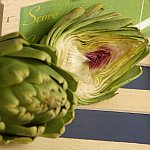|
|
|
Artichoke Fruit Facts Page Information
|
Availability by variety
|
 Artichokes, Historians believe the Artichoke originated in the Mediterranean
countries, possible Sicily or Tunisia. From the 16th century to the end of the
20th century, the Artichoke was made a gourmet item in Paris, France. The ]
Artichoke was thought to have been an aphrodisiac during the 16th century. In
fact, consumption of this rare vegetable was reserved only for men for it was
thought to enhance sexual power.
Artichokes, Historians believe the Artichoke originated in the Mediterranean
countries, possible Sicily or Tunisia. From the 16th century to the end of the
20th century, the Artichoke was made a gourmet item in Paris, France. The ]
Artichoke was thought to have been an aphrodisiac during the 16th century. In
fact, consumption of this rare vegetable was reserved only for men for it was
thought to enhance sexual power.
The word Artichoke comes from the Arabic word al-qarshuf. The name passed into
Spanish during the Middle Ages. The Old Spanish word alcarchofa was variously
modified as it passed through Italian. The name articiocco was then modified
in English, once introduced to the English.
The Artichoke was introduced to California by the Spanish during the nineteenth century.
During this time, many Italian immigrants settled in the coastal city of Half Moon Bay.
In the 1950's, Artichokes earned fame in the state of California, thus giving the status
of the official vegetable for Monterrey County. Today, California provides nearly
100 percent of the Artichokes of the United States Crops.
Consumption:
Pull each leaf off the choke and hold the pointed end between your fingers and
drag the leaf between your teeth. Most of the edible portion is on inside
bottom 1/3 of the choke leaf. Once you've eaten all the leaves you'll see the
heart or flower of the choke. Once you see a bed of fuzzy or hair like strands
you've hit the heart. Scoop out the fuzz with a spoon and discard. The rest of
the base of the choke is edible, referred to as the heart.
Nutrition Facts:
· 1 - 10 ounce, medium artichoke, steamed or boiled
· 60 calories
· 4.2 grams protein
· .2 grams (less than 1 gm) fat
· 13.4 grams carbohydrate
· 114 grams sodium
· 6.5d grams fiber
Detailed nutritional information can be found by searching the
USDA Nutritional Database
. Enter "Artichoke" (no quotes) as the keyword and select the link and
report of interest.
How to Store:
Fresh artichokes should be put in a plastic bag, unwashed, and refrigerated.
It is best to use them within 4 days of purchase. If you grow your own then cut
them right before you cook them
Scientific classification:
The artichoke belongs to the family Asteraceae (formerly Compositae). It is
classified as Cynara scolymus.
|
|